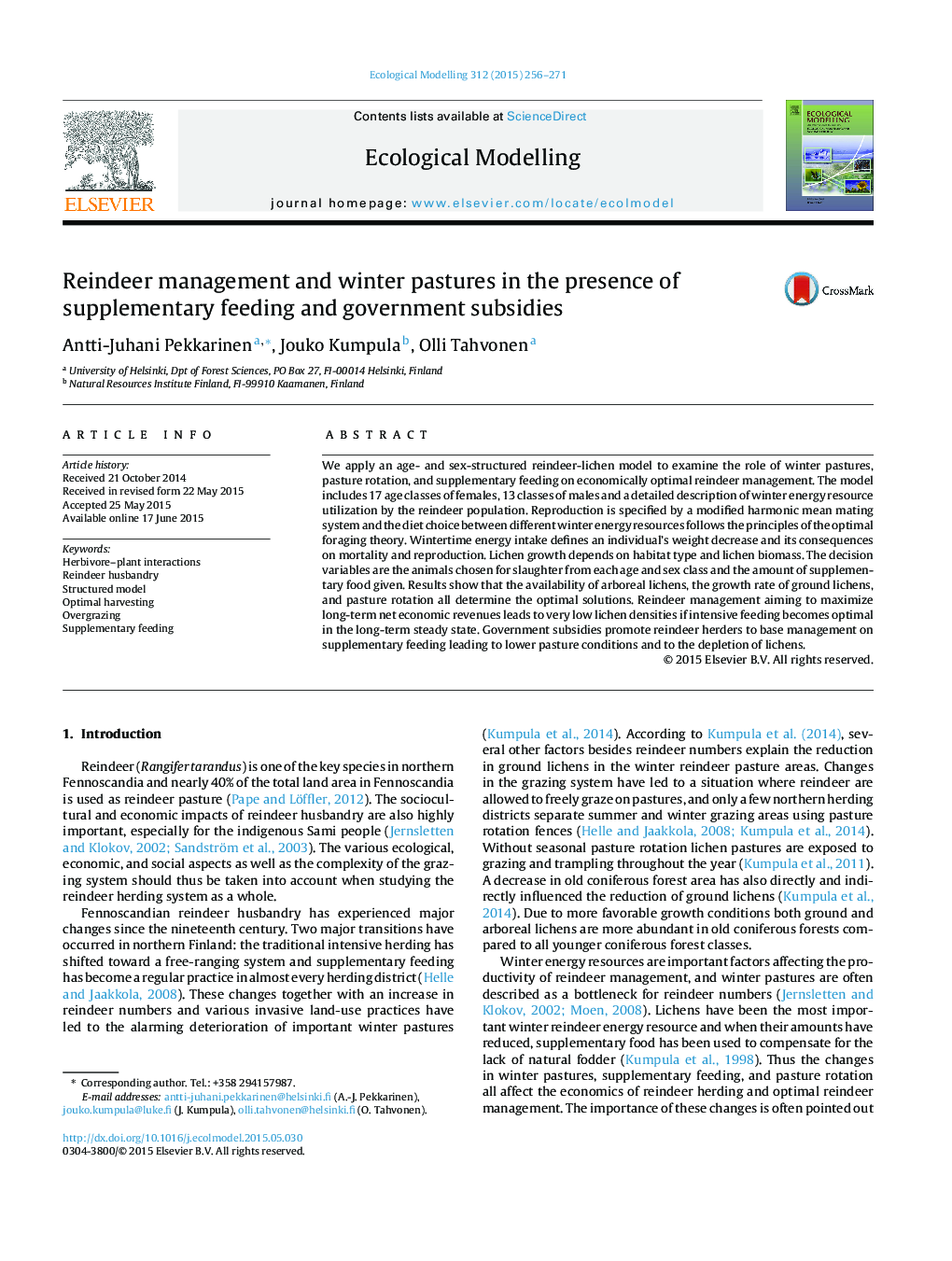| کد مقاله | کد نشریه | سال انتشار | مقاله انگلیسی | نسخه تمام متن |
|---|---|---|---|---|
| 6296553 | 1617435 | 2015 | 16 صفحه PDF | دانلود رایگان |
عنوان انگلیسی مقاله ISI
Reindeer management and winter pastures in the presence of supplementary feeding and government subsidies
ترجمه فارسی عنوان
مدیریت گوزن های شمالی و مراتع زمستانی در حضور تغذیه تکمیلی و یارانه های دولتی
دانلود مقاله + سفارش ترجمه
دانلود مقاله ISI انگلیسی
رایگان برای ایرانیان
کلمات کلیدی
گیاهان متقابل گیاهان، گوزن شمالی، مدل ساختاری، برداشت بهینه، بیش از حد ریشگی، تغذیه تکمیلی،
ترجمه چکیده
ما مدل مدل گوزن و لیچن با سن و جنسیت را برای بررسی نقش مراتع زمستانی، چرخش مرتع و تغذیه تکمیلی در مدیریت اقتصادی بهینه ی گاو نر. این مدل شامل 17 طبقه سنی زنان، 13 کلاس از مردان و شرح مفصلی از استفاده از منابع انرژی زمستان توسط جمعیت گوزن شمالی است. تولید مثل توسط یک سیستم همجوشی اصلاح شده هارمونیکی تعریف شده است و انتخاب رژیم بین منابع مختلف انرژی زمستانی به اصول نظری مطلوب تغذیه می پردازد. مصرف انرژی زمستانی کاهش وزن فرد و پیامدهای آن بر مرگ و میر و تولید مثل را تعیین می کند. رشد لیقن بستگی به نوع زیستگاه و زیست توده لیچه دارد. متغیرهای تصمیم گیری حیوانات انتخاب شده برای کشتار از هر سن و جنس طبقه و مقدار مواد غذایی اضافی داده شده است. نتایج نشان می دهد که دسترسی به لیسه های گیاهان دارویی، سرعت رشد لیسه های خاکی و چرخش علف های هرز، راه حل های بهینه را تعیین می کنند. مدیریت زیستگاه با هدف به حداکثر رساندن درآمد خالص اقتصادی خالص درازمدت منجر به تراکم لیگن بسیار پایین می شود اگر تغذیه شدید در حالت پایدار درازمدت بهینه باشد. یارانه های دولتی گله های گوزن گوزن را به منظور مدیریت پایه در تغذیه تکمیلی، منجر به کاهش شرایط مرتع و تخریب لیسه ها، ترویج می دهند.
موضوعات مرتبط
علوم زیستی و بیوفناوری
علوم کشاورزی و بیولوژیک
بوم شناسی، تکامل، رفتار و سامانه شناسی
چکیده انگلیسی
We apply an age- and sex-structured reindeer-lichen model to examine the role of winter pastures, pasture rotation, and supplementary feeding on economically optimal reindeer management. The model includes 17 age classes of females, 13 classes of males and a detailed description of winter energy resource utilization by the reindeer population. Reproduction is specified by a modified harmonic mean mating system and the diet choice between different winter energy resources follows the principles of the optimal foraging theory. Wintertime energy intake defines an individual's weight decrease and its consequences on mortality and reproduction. Lichen growth depends on habitat type and lichen biomass. The decision variables are the animals chosen for slaughter from each age and sex class and the amount of supplementary food given. Results show that the availability of arboreal lichens, the growth rate of ground lichens, and pasture rotation all determine the optimal solutions. Reindeer management aiming to maximize long-term net economic revenues leads to very low lichen densities if intensive feeding becomes optimal in the long-term steady state. Government subsidies promote reindeer herders to base management on supplementary feeding leading to lower pasture conditions and to the depletion of lichens.
ناشر
Database: Elsevier - ScienceDirect (ساینس دایرکت)
Journal: Ecological Modelling - Volume 312, 24 September 2015, Pages 256-271
Journal: Ecological Modelling - Volume 312, 24 September 2015, Pages 256-271
نویسندگان
Antti-Juhani Pekkarinen, Jouko Kumpula, Olli Tahvonen,
